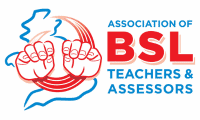Pathway to Becoming a BSL Teacher
Your Journey Starts Here
Welcome to your journey towards becoming a British Sign Language (BSL) teacher! Whether you're just starting out or looking to advance your career, this guide will help you understand the steps involved and the qualifications needed to achieve your goal. BSL teaching is a rewarding profession that not only supports the Deaf community but also promotes the rich linguistic and cultural heritage of BSL.
All BSL teachers have different pathways and journeys, and this guide is designed to help you navigate the various phases and opportunities available to you.
Phase 1:
Joining and Building Your Foundation
Join as an Associate Member
Start by joining our associate membership, which is perfect for aspiring teachers, students, or individuals with non-teaching qualifications from Level 3 or above. This membership will help you develop your interest in the teaching profession and provide valuable resources for your growth.
Achieve High Proficiency in BSL
To become a BSL teacher, you need to be a native deaf BSL user who uses BSL every day. Progress through the BSL levels up to Level 6, which will enhance your understanding of BSL grammar and linguistic features. This foundational knowledge is crucial for teaching BSL effectively.
Phase 2:
Developing Teaching Skills
Understand the Importance of Teaching Skills
Teaching BSL is not the same as using BSL in everyday life. Teaching involves structuring lessons and building a solid learning foundation for students. Like any other subject, such as science, teaching requires specific skills and knowledge to ensure that students learn correctly and safely.
Pursue Initial Teaching Qualifications
Begin with Level 3 teaching qualifications, such as:
Level 3 Award in Education and Training (AET)
Once you have your Level 3 AET qualification, you can upgrade your associate membership to a full membership. Get in touch with [email protected] for upgrading your membership status.
Alternatively, you can join the Sign Language Teacher Training Course (STTC) provided by CityLit or other BSL course providers.
Pathways for Younger Individuals
For younger individuals (ages 16-21), it is advisable to start with Level 1 and 2 in childhood studies, social care, or health. Then, progress to Level 3 or T-Levels in teaching qualifications. This foundational study will help you understand brain and emotional development, which is crucial for building your knowledge and skills to higher levels.
Phase 3:
Advancing in Your Career
Advance to Higher Qualifications
Pursue further teaching qualifications such as:
- Level 4 Certificate in Education and Training (CET)
- Level 5 Diploma in Education and Training (DET)
Achieve a Postgraduate Qualification
Progress to a Postgraduate Certificate in Education (PGCE).
Note that with a PGCE or below, you will be recognised as an unqualified teacher on the pay scale in England and Wales.
Important Note
To progress to qualifications such as QTLS and QTS, you will need Maths and English qualifications from GCSE grade 4 or above (grade C or above for old GCSEs or equivalent to Level 2).
Ensure you meet these requirements before pursuing further qualifications. For more information, visit the Society for Education and Training (SET) or the Teaching Regulation Agency (TRA):
Phase 4:
Advancing Your Credentials
Advance to Higher Qualifications
To be recognised as a fully qualified teacher, you need to obtain Qualified Teacher Learning and Skills (QTLS) status. This qualification will place you on the qualified teacher pay scale in England and Wales.
Alternatively, Achieve Qualified Teacher Status (QTS)
If you work with younger children and teenagers in school settings, you can achieve Qualified Teacher Status (QTS), which is an important qualification for teaching in schools.
Register as a Teacher
In Wales, Scotland, and Northern Ireland, teachers must register with their respective regulatory bodies. While registration is not mandatory in England, it is beneficial. You can voluntarily register with professional organisations such as:
Society for Education and Training (SET) (ideal for those teaching ages 14 to adult, lifelong learning)
Chartered College of Teaching (suitable for primary and secondary settings)
Phase 5:
Advancing and Contributing
Mentoring and Assessing
If you are an experienced BSL teacher, you can mentor trainees and new BSL teachers and assessors. Becoming an assessor in BSL involves marking BSL exams and ensuring the quality and assurance of BSL skills.
Leadership and Management
Advance to leadership roles such as:
ILM Level 5 or other leadership roles in educational settings, such as Head of BSL Department or Deputy roles.
Further your education with Master’s or Doctorate levels in Language, Linguistics, or Education. Focus on research related to sign language that impacts or innovates approaches to Deaf BSL teachers or learners.
Join the ABSLTA Committee
Contribute your skills and experiences by joining the ABSLTA committee. Your involvement can help shape the future of BSL teaching and support the community nationally.
Membership and Benefits
Discover What ABSLTA Offers You

Our Membership
Explore the various membership levels we offer for BSL teachers and assessors.
Membership Options:
- Associate Member: £32.50 per year
- Full Member: £40.00 per year
Join Our MembershipFor more details and to sign up, please click below:

Professional Development
By joining ABSLTA, you gain access to a range of benefits, including:
Explore Membership Benefits- Continuous Professional Development (CPD)
- Sharing ideas and best practices
- Support for your professional growth
- Access to a network of BSL professionals
- Enhance your skills and grow professionally with our support.

Member Access
Access Member PortalAccess our portal to receive newsletters, resources, and network with other BSL teachers and assessors.
Stay updated on CPD opportunities and more.



